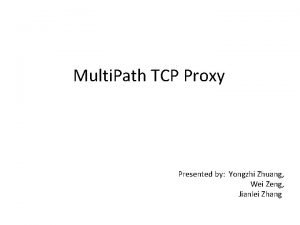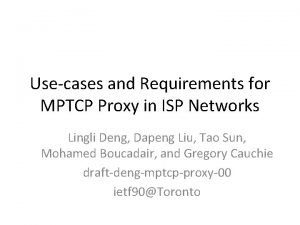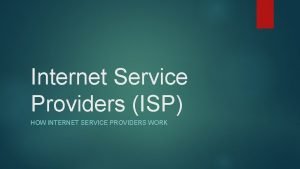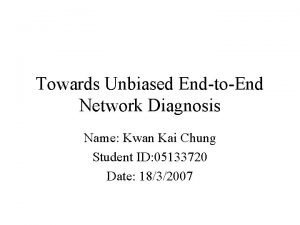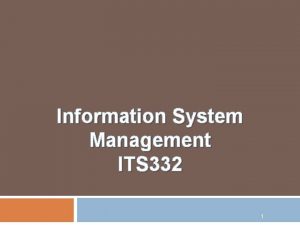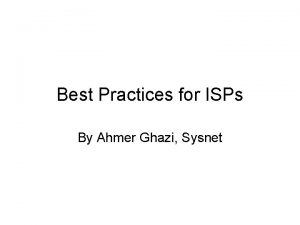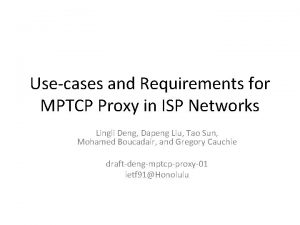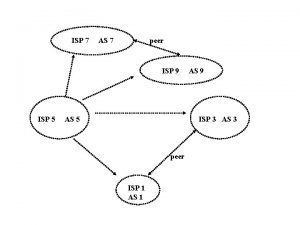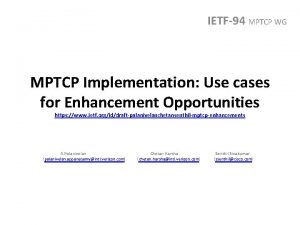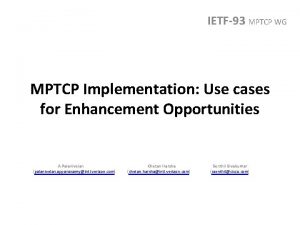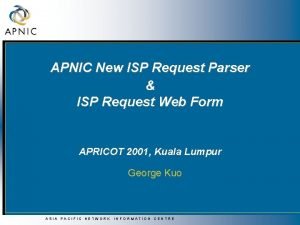Usecases and Requirements for MPTCP Proxy in ISP














- Slides: 14

Use-cases and Requirements for MPTCP Proxy in ISP Networks Lingli Deng, Dapeng Liu, Tao Sun, Mohamed Boucadair, and Gregory Cauchie draft-deng-mptcp-proxy-00 ietf 90@Toronto

Motivations for ISP MPTCP Proxy • Boosting MPTCP Utilization – For M-UEs on behalf of N-Servers – For N-UEs on behalf of multiple access networks • Resource Pooling from Multiple Networks – Flexible Proxy invocation/Pooling strategies depending on (i. e. , subscribers, applications, and ISPs) • Service Continuity for a mobile terminal – Multiple Connections and Seamless Handover between Multiple Networks/Access points • Assist MTPCP Connection Establishment – Terminate or pass MPTCP signal from UE to Server

Deployment Considerations • (1) On-path MPTCP Proxy

Deployment Considerations • (2) Off-path MPTCP Proxy

Deployment Scenarios • For M-client to N-server • IP Gateway from ISP cellular core network • Reusing interfaces for subscriber/network info • LB from ISP/ICP Data Center • Boost MPTCP deployment at the serving side • Cellular/WLAN Dual-mode small cell • Local resource pooling without CN involvement • For N-client to M-server/M-Proxy • CPE/CGN from ISP fixed access network

Requirements for MPTCP proxy • • Protocol transition Traffic Steering for Off-Path Proxying Resource Policy within a Single ISP Protection against third-party traffic MPTCP Proxy Selection from Multiple Candidates Load Balancing Algorithm for Multiple Networks Misc

Protocol transition • Proxy between an M-UE and an N-Server – Compatibility: An on-path MPTCP Proxy supports detection of M-UE/N-server combinations for further proxying while leaving M-UE/M-server and N-UE/N-server sessions intact. – Transparency: An on-path MPTCP Proxy supports negotiation with and acting towards the M-UE like a M-server on behalf of N-Server, while acting towards the N-Server like a N-UE on behalf of the M-UE.

Traffic Steering for Off-Path Proxy • in the off-path MPTCP Proxy use-case – Explicit Traffic Steering: the Proxy MUST support explicit traffic steering, to allow all the subsequent subflow traffic go through the exactly the same MPTCP Proxy used in the corresponding M-session establishment for both directions (including uplink and downlink traffic from/to the M-UE). – Globally Routable Address: the Proxy SHOULD expose a globally routable address to allow explicit steering of subsequent subflow traffic.

Resource Policy within a Single ISP • to enable such fine-grained resource pooling policy from the network, who owns multiple access networks – Network Access Type Information: an MPTCP proxy SHOULD be able to acquire a subflow's Network Access Type information/update. – Resource Policy: an MPTCP Proxy MUST support flexible control to set limits to the number of subflows and the number of M-sessions from an M-UE/to an N-Server.

Protection against 3 rd-party traffic • Provision Negotiation: an MPTCP Proxy SHOULD support both subscriber/Msession/subflow level resource reservation negotiation with a M-UE. • Origin Authentication: an off-path MPTCP Proxy MUST support subflow authentication for traffic from an unauthorized third-party Wi. Fi.

MPTCP Proxy Selection • Multiple proxies from a single ISP – Flexible Selection: it SHOULD be possible for the ISP to enforce flexible selection policy regarding which MPTCP Proxy to serve which M- session, based on • the MPTCP Proxy's location, • the MPTCP Proxy's type (on-path/off-path) • the application type

Load Balancing Algorithm for Multiple Networks • The MPTCP Proxy SHOULD be configurable with the load balancing ratio per each available path. – the ISP may enforce policies that would optimize various parameters such as: • • Network resources usage as a whole. Optimized invocation of available MPTCP Proxies. Optimized MPTCP Proxy local performances. Enhanced Qo. E (including increase both upstream and downstream throughputs)

Misc • Reliability: MUST avoid single point of failure • Scalability: SHOULD be easy to scale • Comlexities with other TCP option signals – SHOULD NOT alter non-MPTCP signals – MUST NOT inject MPTCP signals if the TCP option size is consumed – SHOULD NOT inject MPTCP signals if this leads to local fragmentation – TCP-AO, when present, MUST be the first to be processed

Next Step • call for more review and comment • WG item?
